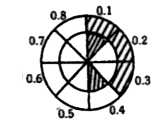Which of the following diagram of cardiac cycle is possible in case of human heart,if the shaded and nonshaded sectors represents different events (systole or diastole)




The correct Answer is:B
To determine which diagram of the cardiac cycle is possible for the human heart, we need to understand the events of the cardiac cycle, specifically systole and diastole.
1. Understand the Cardiac Cycle: The cardiac cycle consists of two main phases:
- Systole: This is the phase where the heart muscle contracts, pumping blood out of the heart. During this phase, the pressure in the heart chambers increases.
- Diastole: This is the phase where the heart muscle relaxes, allowing the chambers to fill with blood. During diastole, the pressure in the heart chambers decreases.
2. Identify the Shaded and Non-Shaded Areas: In the question, the shaded and non-shaded sectors represent different events (systole or diastole). We need to analyze which diagram accurately reflects the relationship between these two phases.
3. Analyze the Options:
- Option A: If it shows only diastole (shaded) without any systole (non-shaded), this is incorrect because a complete cardiac cycle must include both phases.
- Option B: If it shows both systole and diastole with appropriate pressure changes, this could be a valid representation.
- Option C: If it shows only systole (shaded) without any diastole (non-shaded), this is also incorrect for the same reason as Option A.
- Option D: If it shows an irregular pattern without clear distinction between systole and diastole, this would not accurately represent the cardiac cycle.
4. Determine the Correct Diagram: Based on the analysis, the diagram that shows both systole and diastole with appropriate pressure changes is the correct representation of the cardiac cycle.
5. Conclusion: After evaluating the options, Option B is identified as the correct diagram of the cardiac cycle for the human heart, as it accurately represents both the systolic and diastolic phases.
- Systole: This is the phase where the heart muscle contracts, pumping blood out of the heart. During this phase, the pressure in the heart chambers increases.
- Diastole: This is the phase where the heart muscle relaxes, allowing the chambers to fill with blood. During diastole, the pressure in the heart chambers decreases.
- Option A: If it shows only diastole (shaded) without any systole (non-shaded), this is incorrect because a complete cardiac cycle must include both phases.
- Option B: If it shows both systole and diastole with appropriate pressure changes, this could be a valid representation.
- Option C: If it shows only systole (shaded) without any diastole (non-shaded), this is also incorrect for the same reason as Option A.
- Option D: If it shows an irregular pattern without clear distinction between systole and diastole, this would not accurately represent the cardiac cycle.
Topper's Solved these Questions
Similar Questions
Knowledge Check
Which of the following diagram of cardiac cycle is possible in case of human heart,if the shaded and nonshaded sectors represents different events (systole or diastole)
A B
B C
C D
D
Which of the following diagram is/are wrong representation of cardiac cycle?
 A1 and 2B2 and 3C3 and 4D1 and 4
A1 and 2B2 and 3C3 and 4D1 and 4Which of the following genetic events represents a case of incomplete linkage?
AExpression of heterozygous phenotype which is distinct from and often intermediate to that of either parentBInheritance between genes so that one gene prevents expression of other geneCA condition in which the phenotypic effect of a gene's alleles are simultanesouly expressed in heterozygoteDOccasional separtation of two genes on the same chromosome by a recombinant event.
Which of the following diagrams correctly represents the relationship among the classes:
Human beings, Teachers, Graduates

View SolutionWhich of the following brings back deoxygenated blood from different parts of human body to heart?
View SolutionDuring which of the following of the following events of cardiac cycle, AV valves remain closed?
View SolutionWhich of the following events takes place in cardiac cycle after the end of first heart sound and before the onset of second heart sound?
View SolutionWhich of the following correctly explains a phase/event in cardiac cycle in a standard electrocardiogram ?
View Solution

